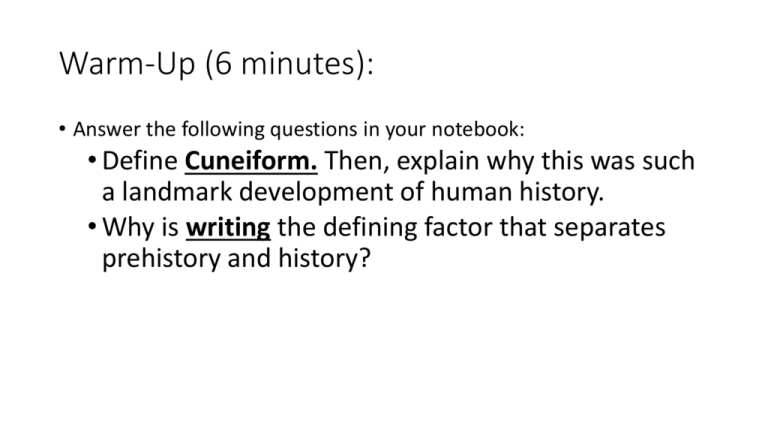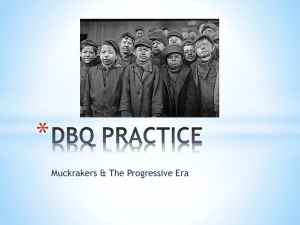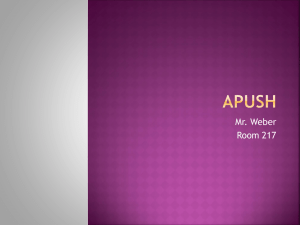PPTUnit1Wk3_AncientWorldClosure
advertisement

Warm-Up (6 minutes): • Answer the following questions in your notebook: • Define Cuneiform. Then, explain why this was such a landmark development of human history. • Why is writing the defining factor that separates prehistory and history? What is this a picture of? Title of Notes: Great Wall of China Keep in mind: We will primarily using the DBQ Packet! • Aim students will analyze (like an archeologist!) historical documents in order to argue whether the Great Wall was a benefit or cost for Ancient China. • Big Idea One of the wonders of the world, can be seen from space, have you heard of the GREAT WALL?! We will learn about Ancient China by breakdown the story of the Great Wall of China. Also, we will be getting our DBQ on! • Homework Complete the Great Wall of China DBQ packet. Begin studying for the Ancient World unit exam, which will begin on Thursday! How do historians learn about the past? Resources! (also known as sources) Primary Resources Secondary Resources Primary Source • A primary resource, or primary source, is a document or artifact created by a person who was there at the time of the historical event being studied. • ARTIFACTS are special primary sources. An artifact is a human-made object, such as a tool, weapon, jewelry or technology. Social scientists called Archeologists study artifacts to learn about the lives of people from the past. Indiana Jones time! 1. 2. 3. 4. 5. 6. 7. I will read the background essay aloud. Let’s pre-bucket! We will analyze Doc A together. You’re welcome! Source, annotate, read, and answer the questions for your assigned document. Your group will present about your document in 10 minutes! Everyone must contribute! (This is a grade!) Create three bucket categories for your documents by labeling the three buckets and putting each document into one of the buckets. We SAPEd the best for last- create a thesis statement! Before you exit . . . • On a half sheet of paper, write down your thesis statement! • Turn this into me on your way out the door. • Tomorrow, bring your completed DBQ packet. • Study, study, study! Warm-Up (6 minutes): • Answer the following questions in your notebook: • Define job specialization. Then, explain what made job specialization possible and why job specialization was an essential component in the development of civilizations. • Why was Hammurabi’s Code such a significant development in human history? Title of Notes: World Religions Keep in mind: We will primarily using the DBQ Packet! • Aim students will be able to apply their understanding of the four aspects of religion when analyzing the impact of religion on human history. • Big Idea One of the wonders of the world, can be seen from space, have you heard of the GREAT WALL?! We will learn about Ancient China by breakdown the story of the Great Wall of China. Also, we will be getting our DBQ on! • Homework Complete the “Rise of Agriculture and Complex Societies” reading and answer the analysis questions! Annotate with a purpose: put a STAR by anything that we have already learned about this year and a QUESTION by anything that seems new and/or unfamiliar! Also, study for the Ancient World unit exam, which will begin on Thursday! What Does it Mean to be Religious? Some Say… • Loving thy neighbor • Consulting witches for wisdom • Obeying a command to be fruitful • Shaving one’s head Others Say… • Wishing a fate on your neighbor worse than death • Burning witches alive • Taking a vow of lifelong celibacy • Never cutting one’s hair Why Study Religion? • It’s the magnet that brings us together; It’s the wedge that drives us apart. • More wars (and hence more murder) has been committed in the name of religion than ANY OTHER FACTOR in history. • It’s what provides some of us with “truth”, while providing others with potential consequence for our actions. Religion – What is it? (Notes) • Write down (in your notes) your version of what the term RELIGION means. • The “Proper” Definition – Write it and compare to your own. • a set of beliefs concerning (4 Aspects of Religion!): • the cause, nature, and purpose of the universe (also known as the COSMOLOGY), • especially when considered as the creation of a superhuman agency or agencies, • usually involving devotional and ritual observances, and • often containing a moral code governing the conduct of human affairs. • Where does it go in the 7CC? Why? How did it all start? Early religious traditions were tied to community life and experience. The earliest attempts at contacting the supernatural may have been designed to ward off misfortune (such as poor harvests or disease), to seek benefits for the living, to mourn and care for the dead, to offer thanks, or simply to honor gods and ancestors. All of these duties were the role of the SHAMAN. Shaman – a person who acts as intermediary between the natural and supernatural worlds “What is Religion?” Reading • Turn to page 6 in your World Religions books. • I will read the first portion of this aloud. • T-Chart annotations in your notebook! • Left side: information that sounds familiar • Right side: information that sounds brand-new Hinduism, Judaism, Buddhism, Chinese and Japanese Religions (Confucianism) • You will be assigned to work in a group to investigate, in-depth, a religion that we have already encountered this year. • In your group, read about that religion in the World Relgions text. • You will create a poster and present about your assigned religion in 20 minutes. Make sure to focus on the following: • Origins of the religion • Four aspects of the religion • The religions impact on human history • Bonus: Information your group learned about the religion that peaked your interest and curiosity! SAPEd by the bell! • In the modern world, should religions lead to more harmony or conflict? Use evidence from what we learned today and what you know about the world we live in. Wednesday • Sample “test” questions • Introduction about what a “lost civilization” entails and how civilizations become “lost”! • https://www.youtube.com/watch?v=etmhB2ZwqJs • Students will use their archeological skills to investigate historical sources (about the Olmecs) and will try to figure out what ancient civilization they are learning about. • Exit Ticket: In the modern world, could a civilization become lost? Use evidence from what we learned today and what you know about the world we live in. Thursday • Writing Portion of Test Friday • Multiple Choice Portion of Test



